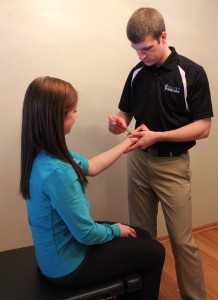Treating Carpal Tunnel Syndrome

If you had to guess what the number one work-related injury is, what would you guess? Neck pain? No. Back pain? Nope, guess again. Carpal tunnel syndrome? Bingo, you are correct.
Carpal tunnel syndrome has been termed the “tennis elbow of the wrist,” accounting for the highest number of workdays lost out of all work-related injuries. Some studies show that it affects one out of every ten people over the course of a lifetime.
With statistics like that, it’s something worth talking about. So what is this work-killing injury carpal tunnel syndrome all about?
Carpal tunnel syndrome occurs when the median nerve is compressed at the wrist because of swollen tendons. This nerve begins at the cervical spine, or neck, and is responsible for the movement and sensation on the palm side of your hands—your palm, thumb and fingers.
This is why carpal tunnel is generally associated with numbness and a needle-like sensation in the affected extremities. Normally, you experience discomfort in your hand after a repetitive and continuous movement, such as: typing on your computer, operating a jackhammer, or working in the garden. Employees of jobs that require a fair amount of repetitive grabbing and reaching are more susceptible to the syndrome.
The actual carpal tunnel is the narrow passageway in your wrists. Bones form the bottom and sides of the tunnel, and a ligament forms the top of the tunnel. Along with the median nerve nine tendons also pass through this tunnel, connecting the muscles that move the hand to bones. When the tendons swell and enlarge, they put pressure on the median nerve, causing compression.
Usually, the thumb, index and middle fingers are involved, and you may notice the symptoms increasing immediately upon waking in the morning or after any activity in which you’re flexing and extending your wrist. Without treatment, the syndrome worsens, causing a decreased grip strength that makes it difficult to perform tasks with the affected hand.
Symptoms of tingling and numbness are not only associated with carpal tunnel syndrome, so it’s important to not rule out other causes, too, such as a neural entrapment or “pinched nerve” in the neck, shoulder or forearm.
 At Elite Sport & Spine, we’ll look at all the areas where the nerve can become entrapped and determine what activities in your life might be causing carpal tunnel. While severe cases may require surgery, chiropractic and manual therapy can help in instances when surgery is not required. For example, manipulating or mobilizing the wrist bones and performing myofascial release on tight tendons and musculature has been shown to be a very effective treatment combination.
At Elite Sport & Spine, we’ll look at all the areas where the nerve can become entrapped and determine what activities in your life might be causing carpal tunnel. While severe cases may require surgery, chiropractic and manual therapy can help in instances when surgery is not required. For example, manipulating or mobilizing the wrist bones and performing myofascial release on tight tendons and musculature has been shown to be a very effective treatment combination.
Graston Technique is one form of myofascial release that incorporates a patented form of instrument-assisted soft tissue mobilization. Using small stainless steel instruments, the treatment allows doctors to detect and treat scar tissue and restrictions that effect normal function.
Six different instruments are used in Graston Technique, each one designed and contoured for different areas of the body. In gliding the instruments over the skin, scar tissue is broken up, increasing range of motion and improving function. It also reduces the symptoms of carpal tunnel, so that the tingling and needles are almost entirely diminished.
One private study which was presented at the American Occupational Therapy Association Annual Conference and Exposition found that, “eighty-one percent of carpal tunnel syndrome patients attained 80 to 100% of decreased pain and increased function goals in 10 treatments with the Graston Technique” (2000 Apr.).
If you’re suffering from carpal tunnel syndrome, don’t live with the pain. Call us at (262) 289-9220 and set up a consultation with Dr. Shiels today. You deserve to be pain free.
 262-373-9168
262-373-9168




